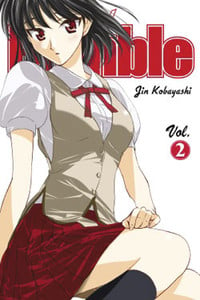Review
by Carl Kimlinger,School Rumble
G.novel 2
| Synopsis: |  |
||
It's business as usual for the School Rumble crowd: eating, sleeping, attending classes, dealing with ghosts and psychic powers, and adding yet more links to the lengthening chain of unrequited loves that is class 2-C. This time out, the class cleans the school pool—by playing soap-hockey, Tenma goes on an educational odyssey towards cooking competency, and Harima has his heart broken. Will everything turn out for the best? Almost certainly not. |
|||
| Review: | |||
It's very easy to see why School Rumble has gotten as far as it has (it's the rare shounen romance that manages to parlay itself into two full seasons of anime): to put it in the simplest of terms, it's undiluted fun. It starts off with simple ingredients, many of them staples, but the expert touch with which they're blended makes for a superior dish. It is a high-school romance, so many very familiar elements are on display: unrequited crushes, romantic misunderstandings, love letters (although not in this volume), sports competitions, the "girl who can't cook." The list could go on for miles. But the list is more remarkable for the genre tropes that aren't included. There is no flock of girls inexplicably attracted to some personality-challenged schmuck, no contrived moments of gooey romanticism, no endless panty-shots (although there is some fan-service), no booby face-plants or accidental de-pantsings, and absolutely no (thank god) "little sister" romantic interests. It's as if Jin Kobayashi purposely trimmed from his manga all of the annoying and despicable bits that tend to cling to shounen romances like so many blood-sucking insects. So, when the class gets assigned to pool-cleaning duty, instead of a wet T-shirt fest, he delivers a fast-paced game of soap-cake hockey that is crammed to the gills with gags and skillfully interwoven with demonstrations of various characters' personality quirks and traits. The entire volume follows this pattern. The humor is fast and furious, driven to gag-per-page speeds by the staccato pacing of the 8-10 page chapters. And in between (and during) the jokes, characters quietly reveal themselves piecemeal to the audience. The wonder of this character-building is that (with a few exceptions) it never feels like Kobayashi is "constructing" his characters. Instead he assigns each character a strong and clearly defined (if occasionally stereotypical) personality and then allows it to manifest itself via their actions and reactions. As a result, rather than a cast that has been introduced to you, the characters feels like friends that you have gotten to know on your own. Of course it helps that, despite their flaws, every man-jack of them is a likable cuss. Naturally, if it were nothing but non-stop gags, the manga would quickly wear out its welcome. Kobayashi knows this as well as anyone. Interspersed throughout are mildly downbeat chapters (one involving Yakumo and a ghost, one about Eri and her father, and yet another about Yakumo making her first good friend). The unholy glee with which Kobayashi torments his characters (particularly Harima) with worst-possible-scenario romantic developments also colors the manic humor with a melancholy tinge that keeps it from getting overbearing. The first volume's greatest weakness was that nothing happened. This volume rectifies the situation to a certain extent by putting Harima through love's wringer. However, the fact remains that, outside of this, nothing happens. But, such is high school. Kobayashi's artwork looks its best during the heavily cross-hatched, darkly shadowed action and high-impact scenes. Outside of the aforementioned scenes, his art is attractive, yet undistinguished. His characters (except Harima and Karasuma) sport dangerously generic anime-styled designs and are memorable solely because of their disparate personalities. Backgrounds, while adequate for indicating settings, are obscured by speed-lines, auras, and effects (flowers, skulls, etc.) or are simply missing altogether the vast majority of the time. Nevertheless, his art has a simple, comfortable flow and is never less than pleasing. Flow is aided by sensible rectangular panels and a growing aptitude for portraying movement, although the number of panels per page sometimes leaves the artwork looking crowded. Del Rey's habit of including translator's notes as an end-of-book extra is especially welcome in a comedy such as this, where jokes are often dependent on cultural knowledge. Also in the back of the book is a short preview of the next volume. The front of the book contains an explanation of honorifics and a note on the Japanese order of characters' names. Like the volume before (and likely volumes after), this volume of School Rumble sucks you in one end and spits you out the other with a big grin on your face and a mild case of the warm fuzzies. That this volume also features some evolution in the primary relationships is simply frosting on your comedy cake. |
|
The views and opinions expressed in this article are solely those of the author(s) and do not necessarily represent the views of Anime News Network, its employees, owners, or sponsors.
|
| Grade: | |||
Overall : B
Story : C+
Art : B
+ Oft-hilarious comedy with a likable cast and a surprising melancholy edge. |
|||
| discuss this in the forum (3 posts) | | |||
| Production Info: | ||
|
Full encyclopedia details about Release information about |
||